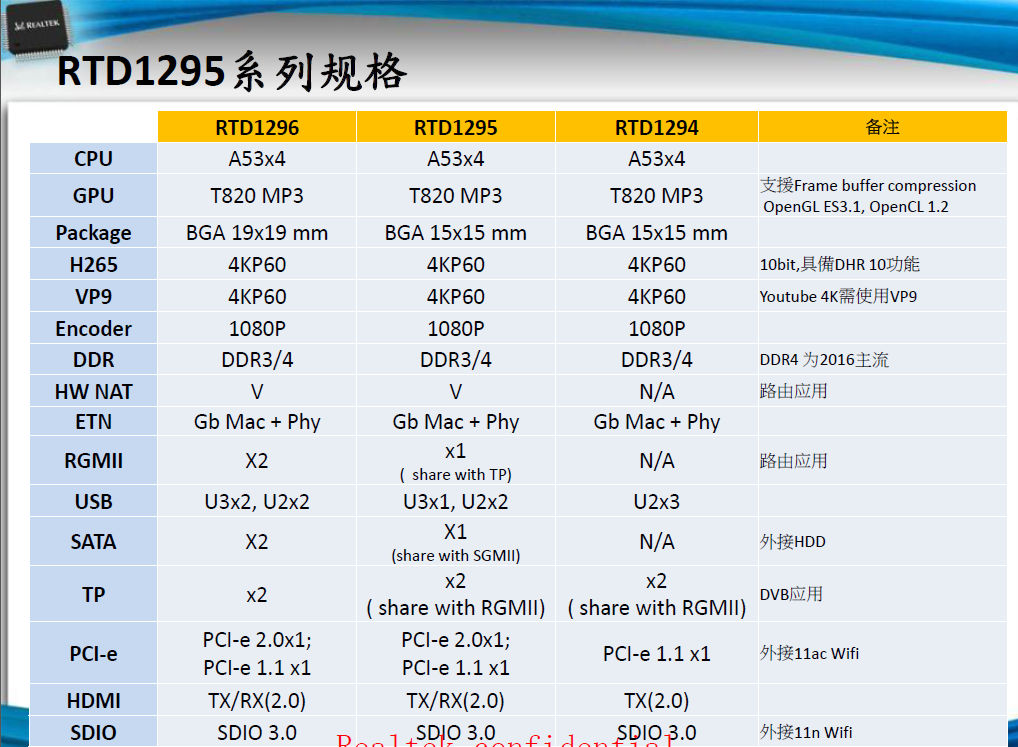I have reviewed several Realtek RTD1295 TV boxes with NAS and HDMI input functions such as Zidoo X9S and EWEAT R9 Plus, and those were quite capable devices with a rich feature set, but Realtek has been working on a new higher-end RTD1296 SoC for quite some time. It comes with the same CPU and GPU, but has a larger package with more peripheral interfaces.

I received the screenshot above last December, but the information does not seem to have changed since then. Realtek RTD1296 is equipped with a quad core Cortex A53 processor, an ARM Mali-T820MP3 GPU, and the same H.265/VP9 video engine as RTD1295. However, the new SoC adds one extra RGMII (Gigabit Ethernet) interface, one more USB 3.0 port, one extra SATA interface, and offers higher DDR bandwidth. The PCIe interface would also allow you to use more than just two SATA drives.
Charbax got in touch with the company, and shot a video showcasing their various RTD1296 solutions include and Android TV STB with Voice Assistant (not the Google One yet) which allows you to turn on the box, PIP recording for game streamers on YouTube, Twitch…, and some Synology and QNAP NAS based on RTD129X (exact part not provided).
Via ARMDevices

Jean-Luc started CNX Software in 2010 as a part-time endeavor, before quitting his job as a software engineering manager, and starting to write daily news, and reviews full time later in 2011.
Support CNX Software! Donate via cryptocurrencies, become a Patron on Patreon, or purchase goods on Amazon or Aliexpress





anyone like to use RTD1296 do a development board ??
In the meantime RTD1296 went Bananas: http://archive.is/osCuS (it’s only Cortex-A5 any more, can’t do 4K but just 1080p, the interfaces description is weird to say the least and SinoVoip even invented PCIe 2.2 which nowhere else exists).
The board looks interesting (I’m wondering who the design did?) but I really can’t believe that this company is still not able to provide any correct information (calling this copy&paste nonsense ‘technical documentation’ would be an insult for every technical writer out there). This level of failure in year 3 now is just bizarre. Really amazing 🙂
On gitbook you’ll find the corrected specs:
https://www.gitbook.com/book/bananapi/banana-pi-bpi-w2-with-realtec-rtd1296/details
@Gabe
No, unfortunately not. This is just different copy&paste gone wrong (see PCIe 2.2 I already quoted from these ‘specs’). It seems their average customers don’t care about correctness and are happy with getting not technical documentation but just some gitbook pages filled with random text, numbers and some pictures. Well, mission accomplished (selling hardware). From a developer or integrators point of view this is only disgusting since you can’t trust any ‘information’ provided there since you can never be sure whether it’s correct by accident or wrong as usual.
And then this company is surprised why there is zero developer community around. Not only me had some hope the last weeks that things would change with this vendor but… they prove us all wrong (you can’t allow someone who simply doesn’t care about the meaning of words and numbers to provide ‘information’ or even ‘documentation’/’specs’. Everyone around understands this but things in the little Banana world seem to work differently 🙂 )
@tkaiser
@Gabe
They must have read your comments since everything is corrected.
SinoVoIP unveil boards early, so I guess that’s a 2018 release date.
Huh? Nothing is corrected, ‘their’ RTD1296 is still a crippled one since not 4K capable any more, they’re still the only vendor on this planet providing PCIe 2.2 while at the same time they are not able to tell users how many lanes are available (so interested users have to visit to this cnxsoft blog post, watch on the picture on top to know that both PCIe slots are just x1).
BTW: Babbling about PCIe 2.2 is not a real problem since everyone interested knows that it’s PCIe 2.0 or 2.1 and differences don’t matter. It’s just that providing ‘technical documentation’ by copy&paste from other wiki pages and then not even trying to find all the mistakes simply doesn’t work. And the person allowed to do this has obviously not the slightest idea what he’s doing, eg. mentioning ‘TYPE C’ or ‘M.2’ is… weird to stay polite. Technical documentation deals with what’s available on such multipurpose connectors.
I had some hope that things improve but no 🙁 It’s simply absurd to deal with a vendor you now have to fight for correct information in the 3rd year. Avoiding is more easy.
Next version will be RTD1395 announced at CES 2018 with few details: